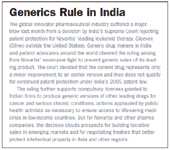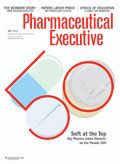Generic Drug Gains and Grumbles
Legal battles and regulatory missteps undermine access to low-cost generics, at home and abroad, writes Jill Wechsler.
All the reports on the rise and fall in drug spending have one common feature: most savings come from increased use of generic drugs. Low-cost copycat medicines now account for more than 80 percent of US prescriptions, the number rising in recent years as more blockbuster therapies have lost patent protection.
The trend has heightened competition between generics and innovator products, as seen in heated battles over access to brand supplies for testing purposes and efforts by brands to delay approval and sales of biosimilars. A controversial Food and Drug Administration decision last month blocked generic makers from selling copycat versions of the original OxyContin painkiller when its patent expired April 16. The agency instead approved labeling citing anti-abuse features of a newer formulation of the product marketed by Purdue Pharma since 2010. Considered a "gift" to Purdue, the decision reflects pressure from state and federal officials who opposed FDA approval of cheap, easily abused drugs that would further fuel the epidemic of prescription drug abuse raging across the nation.
The fight for market share is just as intense on the international front, as seen in the recent landmark patent case in India (see sidebar). In the United States, though, generic makers and brands are allied in contentious Supreme Court cases. Meanwhile, generic drug manufacturing problems have led to serious shortages in key therapies, prompting FDA to propose new strategies for ensuring product quality that have disrupted regulatory operations.
Supreme decisions
Generic and brand companies are watching closely for two key rulings from the Supreme Court in June. The FTC v. Activis case (docket no. 12-416) has received extensive media attention as it challenges "pay-for-delay" patent settlements between brand and generics manufacturers that determine when a generic competitor comes to market. The Federal Trade Commission has long attacked "reverse payment" deals as anti-competitive and harmful to consumers and now wants the court to declare them per se illegal. Both brand and generics firms counter that the arrangements avoid costly litigation and actually permit generics marketing prior to patent expiration. Democrats have proposed legislation to ban these settlements and will try to move forward if the high court fails to squash the deals.
The Mutual Pharmaceutical Co. v. Bartlett case (docket no. 12-142) is more technical, but raises important questions about whether lower courts can challenge FDA regulatory decisions, here involving when and how generic drug makers can revise labels to reflect important new safety information. A patient who took Mutual's generic drug and suffered hideous adverse events sued and won a $21 million judgment based on the company's failure to warn of the drug's potential dangers. Mutual argues that the long-marketed, anti-inflammatory and its label were approved by FDA, and the Justice Department agrees that states can't override federal regulatory policy, which would undermine the FDA approval process and open the door to multiple drug liability cases. This is the third case in recent years that has raised generic drug safety labeling issues, and there's growing pressure for statutory revisions that allow—or require—generics makers to add warnings to labels, even if the information differs from a reference product.

Shortages and competition
Generic drug companies also have suffered in the court of public opinion from manufacturing lapses and product quality problems that have led to critical shortages in important medicines, particularly for sterile injectable cancer therapies, analgesics, and anesthetics. FDA has strengthened its monitoring of shortage problems and taken steps to make alternative therapies available to patients, but low prices on these hard-to-produce drugs have deterred competitors from entering the injectables market.
Now the economic picture seems to be attracting new players to the field. Becton Dickinson (BD) recently announced FDA approval of an injectable antihistamine in pre-filled syringes, the first of a new line of pre-filled generic injectables.
Similarly, Jordan-based Hikma has expanded sterile injectable production capacity at its New Jersey plant following FDA approval of several injectable generic therapies, and Teva is expanding production of injectables at its facility in Hungary. BD acknowledges that its prefilled products will be more expensive than existing generic injectables, but claims they will be safer and easier to administer. The company is betting that providers and payers will accept higher prices for a more reliable, high-quality supply of necessary therapies.
FDA changes
Meanwhile, FDA's regulatory program for approving new generic therapies has been shaken by a series of organizational changes affecting the Office of Generic Drugs (OGD). The head of that office, Gary Geba, departed suddenly in March after less than a year on the job (see PharmExec.com posting, March 2013), apparently unhappy about a reorganization at the Center for Drug Evaluation and Research that would combine generic and new drug review chemists in a new Office of Pharmaceutical Quality (OPQ). Ever since the OPQ proposal emerged last fall, OGD staffers have raised concerns about decimating the generic drug review process. The change also appears to counter a move by CDER director Janet Woodcock last September to elevate OGD to "super office" status directly reporting to her.

Generics Rule in India
Similarly, staffers in CDER's Office of Compliance are leery about OPQ swallowing up much of its Office of Manufacturing and Product Quality. The idea is to combine operations responsible for evaluating manufacturing data in applications for new drugs and generics with those overseeing compliance with good manufacturing practices, but that seems to involve stepping on a lot of toes.
To lend stability to the situation, Woodcock recently named agency veteran Kathleen Uhl as OGD acting director. Uhl faces the tricky task of implementing a more efficient application review process, overseeing more timely field inspections, whittling down an enormous review backlog, and establishing the new generic drug user fee program. She comes to the job with experience as a CDER reviewer, as head of FDA's Office of Women's Health and most recently deputy director of CDER's Office of Medical Policy, where she was involved with negotiations related to FDA's new biosimilars program. Uhl will need all her experience navigating the drug regulatory arena to meet public demand for high quality—and affordable—generic therapies.
Jill Wechsler is Pharm Exec's Washington correspondent. She can be reached at jwechsler@advanstar.com.

Pfizer, GSK Gain ACIP Recommendations for RSV and Meningococcal Vaccines
April 18th 2025The Centers for Disease Control and Prevention’s Advisory Committee on Immunization Practices voted to expand access to Pfizer’s respiratory syncytial virus vaccine Abrysvo for high-risk adults in their 50s and voted in favor of GSK’s meningococcal vaccine, Penmenvy, for streamlined adolescent protection.
Navigating Distrust: Pharma in the Age of Social Media
February 18th 2025Ian Baer, Founder and CEO of Sooth, discusses how the growing distrust in social media will impact industry marketing strategies and the relationships between pharmaceutical companies and the patients they aim to serve. He also explains dark social, how to combat misinformation, closing the trust gap, and more.